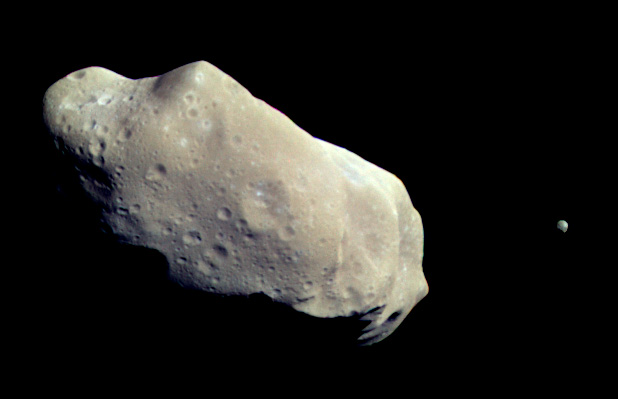Binary Minor Planet on:
[Wikipedia]
[Google]
[Amazon]

 A binary asteroid is a system of two
A binary asteroid is a system of two
2006VW139.gif, Time-lapse video of binary main-belt comet (288P)
The double asteroid 90 Antiope - Eso0718a (no tagline).jpg, Artist's impression of the double asteroid 90 Antiope

 A binary asteroid is a system of two
A binary asteroid is a system of two asteroid
An asteroid is a minor planet—an object larger than a meteoroid that is neither a planet nor an identified comet—that orbits within the Solar System#Inner Solar System, inner Solar System or is co-orbital with Jupiter (Trojan asteroids). As ...
s orbiting their common barycenter
In astronomy, the barycenter (or barycentre; ) is the center of mass of two or more bodies that orbit one another and is the point about which the bodies orbit. A barycenter is a dynamical point, not a physical object. It is an important con ...
. The binary nature of 243 Ida
243 Ida is an asteroid in the Koronis family of the asteroid belt. It was discovered on 29 September 1884 by Austrian astronomer Johann Palisa at Vienna Observatory and named after Ida (nurse of Zeus), a nymph from Greek mythology. Later telesc ...
was discovered when the Galileo spacecraft
''Galileo'' was an American robotic space probe that studied the planet Jupiter and its moons, as well as the asteroids Gaspra and Ida. Named after the Italian astronomer Galileo Galilei, it consisted of an orbiter and an entry probe. It wa ...
flew by the asteroid in 1993. Since then numerous binary asteroids and several triple asteroids have been detected.
The mass ratio of the two components – called the "primary" and "secondary" of a binary system – is an important characteristic. Most binary asteroids have a large mass ratio, i.e. a relatively small satellite in orbit around the main component. Systems with one or more small moons – also called "companions" or simply "satellites" – include 87 Sylvia, 107 Camilla and 45 Eugenia (all triples), 121 Hermione, 130 Elektra (a quadruple), 22 Kalliope, 283 Emma, 379 Huenna, 243 Ida and 4337 Arecibo (in order of decreasing primary size). Some binary systems have a mass ratio near unity, i.e., two components of similar mass. They include 90 Antiope, , and 69230 Hermes, with average component diameters of 86, 1.8, 0.9 and 0.8 km, respectively.
In August 2024 Gaia
In Greek mythology, Gaia (; , a poetic form of ('), meaning 'land' or 'earth'),, , . also spelled Gaea (), is the personification of Earth. Gaia is the ancestral mother—sometimes parthenogenic—of all life. She is the mother of Uranus (S ...
reported 352 new binary asteroid candidates.
Description
Several theories have been posited to explain the formation of binary-asteroid systems. Many systems have significant macro-porosity (a " rubble-pile" interior). The satellites orbiting largemain-belt asteroids
The asteroid belt is a torus-shaped region in the Solar System, centered on the Sun and roughly spanning the space between the orbits of the planets Jupiter and Mars. It contains a great many solid, irregularly shaped bodies called asteroi ...
such as 22 Kalliope, 45 Eugenia or 87 Sylvia may have formed by disruption of a parent body after impact or fission after an oblique impact. Trans-Neptunian binaries may have formed during the formation of the Solar System by mutual capture or three-body interaction. Near-Earth asteroids
A near-Earth object (NEO) is any small Solar System body orbiting the Sun whose closest approach to the Sun (perihelion) is less than 1.3 times the Earth–Sun distance (astronomical unit, AU). This definition applies to the object's orbit aro ...
, which orbit in the inner part of the Solar System, most likely form by spin-up and mass shedding, likely as a result of the YORP effect. Numerical simulations suggest that when solar energy spins a “rubble pile” asteroid to a sufficiently fast rate by the YORP effect, material is thrown from the asteroid's equator. This process also exposes fresh material at the poles of the asteroid.
Gallery
See also
* * * Contact binary (small Solar System body) * Triple asteroids andReferences
{{Small Solar System bodies